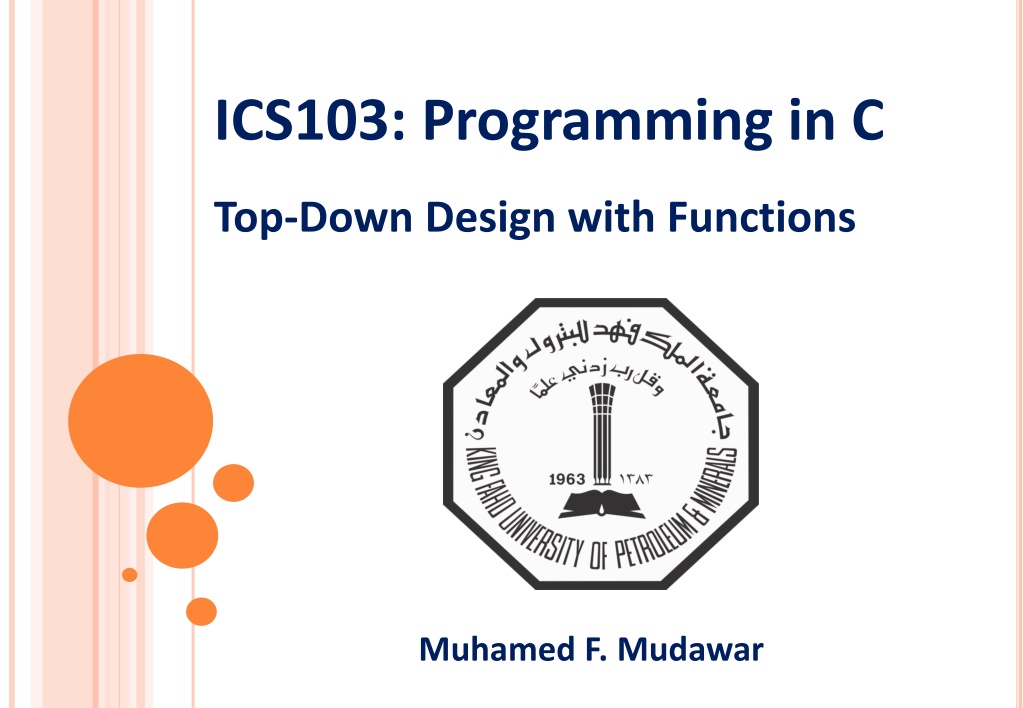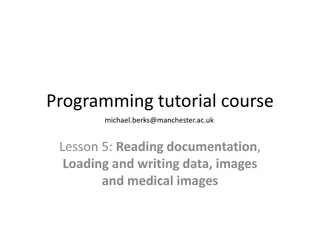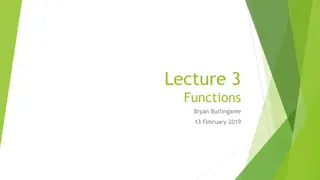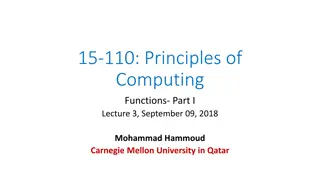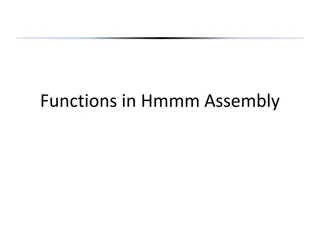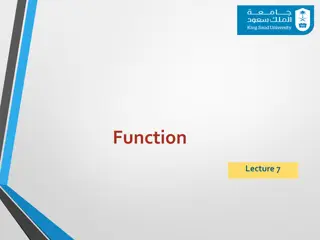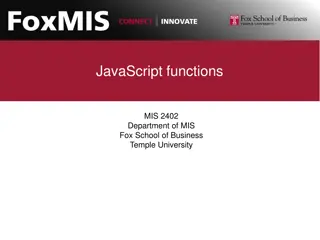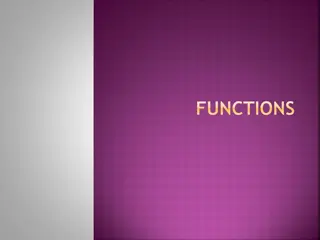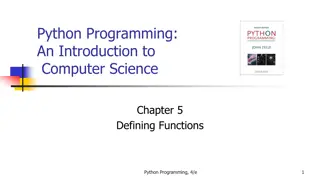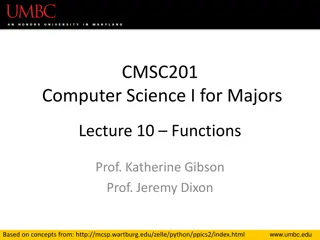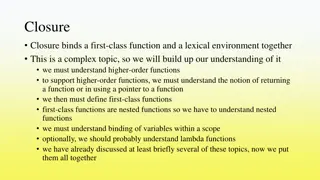Introduction to Programming in C: Top-Down Design with Functions
Learn about the fundamental aspects of programming in C focusing on top-down design with functions, code reuse, and the importance of library functions. Explore the concept of functions, their input arguments, and result values, along with examples of mathematical library functions like sqrt, exp, log, sin, and cos.
Download Presentation

Please find below an Image/Link to download the presentation.
The content on the website is provided AS IS for your information and personal use only. It may not be sold, licensed, or shared on other websites without obtaining consent from the author. Download presentation by click this link. If you encounter any issues during the download, it is possible that the publisher has removed the file from their server.
E N D
Presentation Transcript
ICS103: Programming in C Top-Down Design with Functions Muhamed F. Mudawar
OUTLINE Introduction to Functions Library Functions and Code Reuse Top-Down Design and Structure Charts Functions without Arguments or Results Function Prototypes, Definitions, and Function Calls Functions with Input Arguments and a Single Result Testing Functions and Function Data Area 2 Advantages of Functions and Common Errors
INTRODUCTIONTO FUNCTIONS So far, we know how to use operators: + * / % to form simple arithmetic expressions However, we are not yet able to write many other mathematical expressions we are used to For example, we cannot yet represent any of the following expressions in C: ? , ??, log? C does not have operators for square root, exponential, log, sine, etc. Instead, C provides program units called functions to carry out these and other mathematical operations 3
INTRODUCTIONTO FUNCTIONS A function is like a box that receives input arguments and returns a result value For example: y = sqrt(x); x is the input argument The result value is assigned to y For example: y = sqrt(16.0); The result value is 4.0 The math library provides many standard functions in C 4
LIBRARY FUNCTIONSAND CODE REUSE The primary goal of software engineering is to write error- free code. Reusing code that has already been written and tested is one way to achieve this. C promotes code reuse by providing library functions. Input/Output functions: printf, scanf , etc. Mathematical functions: sqrt, exp, log, etc. String functions: strlen, strcpy, strcmp, etc. 5 Appendix B lists many C standard library functions
SOME MATHEMATICAL LIBRARY FUNCTIONS Function Header file Argument Result Example abs(x) <stdlib.h> int int abs(-5) is 5 fabs(x) <math.h> double double fabs(-2.3) is 2.3 sqrt(x) <math.h> double double sqrt(2.25) is 1.5 exp(x) <math.h> double double exp(1.0) is 2.71828 log(x) <math.h> double double log(2.71828) is 1.0 log10(x) <math.h> double double log10(100.0) is 2.0 pow(x,y) <math.h> double, double double pow(2.0,3.0) is 8.0 returns xy sin(x) <math.h> double double sin(PI/2.0) is 1.0 cos(x) <math.h> double double cos(PI/3.0) is 0.5 tan(x) <math.h> double double tan(PI/4.0) is 1.0 8 ceil(x) <math.h> double double ceil(45.2) is 46.0 floor(x) <math.h> double double floor(45.2) is 45.0
USING MATH LIBRARY FUNCTIONS #include <math.h> Computing the roots of: ax2 + bx + c = 0 delta = b*b 4*a*c; root1 = (-b + sqrt(delta))/(2.0 * a); root2 = (-b - sqrt(delta))/(2.0 * a); Computing the unknown side of a triangle a2 = b2 + c2 2 b c cos( ) a = sqrt(b*b + c*c - 2*b*c*cos(alpha)); 9 alpha must be in radians
NEXT . . . Introduction to Functions Library Functions and Code Reuse Top-Down Design and Structure Charts Functions without Arguments or Results Function Prototypes, Definitions, and Function Calls Functions with Input Arguments and a Single Result Testing Functions and Function Data Area 10 Advantages of Functions and Common Errors
TOP-DOWN DESIGN Algorithms are often complex To solve a problem, the programmer must break it into sub-problems at a lower level This process is called top-down design Examples: Drawing Simple Diagrams 11
STRUCTURE CHARTS Structure Charts show the relationship between the original problem and its sub-problems. The sub-problem (Draw a triangle) can also be refined. It has its own sub-problems at level 2. 12
FUNCTIONS WITHOUT ARGUMENTS One way to achieve top-down design is to define a function for each sub-program. For example, one can define functions to draw a circle, intersecting lines, base line, and a triangle. To draw a circle, call the function: draw_circle(); /* No argument, No result */ To draw a triangle, call the function: draw_triangle(); /* No argument, No result */ 13 The above draw functions have no arguments
FUNCTIONSTO DRAW A STICK FIGURE NO ARGUMENT NO RESULT 14
FUNCTION PROTOTYPES A function must be declared before it can be used in a program. To do this, you can add a function prototype before main to tell the compiler what functions you are planning to use. A function prototype tells the C compiler: 1. The result data type that the function will return 2. The function name 3. Information about the arguments that the function expects Function prototypes for draw_circle and sqrt void draw_circle(void); 16 double sqrt(double x);
FUNCTION PROTOTYPES Before main function Draws This Stick Figure 17 17
FUNCTION DEFINITION A function prototype tells the compiler what arguments the function takes and what it returns, but NOT what it does A function definition tells the compiler what the function does Function Header: Same as the prototype, except it does not end with a semicolon ; Function Body: enclosed by { and } containing variable declarations and executable statements No Result No Argument 18
PLACEMENTOF FUNCTIONSINA PROGRAM In general, declare all function prototypes at the beginning (after #includeand #define) This is followed by the main function After that, we define all of our functions However, this is just a convention As long as a function s prototype appears before it is used, it doesn t matter where in the file it is defined The order we define functions in a program does not 19 have any impact on how they are executed
EXECUTION ORDEROF FUNCTIONS Program execution always starts in main function Execution order of functions is determined by the order of the function call statements At the end of a function, control returns immediately after the point where the function call was made function call 20
NEXT . . . Introduction to Functions Library Functions and Code Reuse Top-Down Design and Structure Charts Functions without Arguments or Results Function Prototypes, Definitions, and Function Calls Functions with Input Arguments and a Single Result Testing Functions and Function Data Area 21 Advantages of Functions and Common Errors
FUNCTIONSAND ARGUMENTS We use arguments to communicate with the function Two types of function arguments: Input arguments: pass data from the caller to the function Output arguments: pass results from the function back to the caller [chapter 6] Types of Functions No input arguments (void) and no value returned (void) Input arguments, but no value returned (void) Input arguments and single value returned 22 Input arguments and multiple values returned [chapter 6]
FUNCTIONWITH INPUT ARGUMENT BUT NO RETURN VALUE void print_rboxed(double rnum); Display its double argument rnum in a box void function No return value Sample Run 23
FORMALAND ACTUAL PARAMETERS Formal Parameter An identifier that represents a parameter in a function prototype or definition. Example: void print_rbox(double rnum); The formal parameter is rnum of type double Actual Parameter (or Argument) An expression used inside the parentheses of a function call Example: print_rbox(x+y); /* function call */ Actual argument is the value of the expression x+y Parameters make functions more useful. Different arguments are passed each time a function is called. 24
FUNCTIONSWITH INPUT ARGUMENTSAND A SINGLE RESULT VALUE /* area of a circle */ double circle_area(double r) { return (PI * r * r); } /* diagonal of rectangle */ double rect_diagonal(double l, double w) { double d = sqrt(l*l + w*w); return d; } 25 Functions in the math library are of this category
TESTING FUNCTIONS USING DRIVERS A function is an independent program module It should be tested separately to ensure correctness A driver function is written to test another function Input or define the arguments Call the function Display the function result and verify its correctness 26 We can use the main function as a driver function
TESTING FUNCTIONrect_diagonal /* Testing rect_diagonal function */ int main(void) { double length, width; /* of a rectangle */ double diagonal; /* of a rectangle */ printf("Enter length and width of rectangle> "); scanf("%lf%lf", &length, &width); diagonal = rect_diagonal(length, width); printf("Result of rect_diagonal is %f\n", diagonal); return 0; 27 }
THE FUNCTION DATA AREA Each time a function call is executed, an area of memory is allocated for formal parameters and local variables Local Variables: variables declared within a function body Function Data Area: Formal Parameters + Local Variables Allocated when the function is called Can be used only from within the function No other function can see them The function data area is lost when a function returns 28 It is reallocated when the function is called again
EXAMPLEOF FUNCTION DATA AREAS diagonal = rect_diagonal(length, width); Function main Data Area Function rect_diagonal Data Area length l pass 1.5 1.5 width w pass 2.0 2.0 diagonal d return 29 ? 2.5
ARGUMENT LIST CORRESPONDENCE The Number of actual arguments used in a call to a function must be equal to the number of formal parameters listed in the function prototype. The Order of the actual arguments used in the function call must correspond to the order of the parameters listed in the function prototype. Each actual argument must be of a data Type that can be assigned to the corresponding formal parameter 30 with no unexpected loss of information.
ADVANTAGESOF FUNCTIONS A large problem can be better solved by breaking it up into several functions (sub-problems) Easier to write and maintain small functions than writing one large main function Once you have written and tested a function, it can be reused as a building block for a large program Well written and tested functions reduce the overall length of the program and the chance of error Useful functions can be bundled into libraries 31
PROGRAMMING STYLE Each function should begin with a comment that describes its purpose, input arguments, and result Include comments within the function body to describe local variables and the algorithm steps Place prototypes for your own functions in the source file before the main function Place the function definitions after the main function in any order that you want 32
COMMON PROGRAMMING ERRORS Remember to use #includedirective for every standard library from which you are using functions For each function call: Provide the required Number of arguments Make sure the Order of arguments is correct Make sure each argument is the correct Type or that conversion to the correct type will not lose information. Document and test every function you write Do not call a function and pass arguments that are out of range. A function will not work properly when passing invalid arguments: sqrt(-1.0) 33
